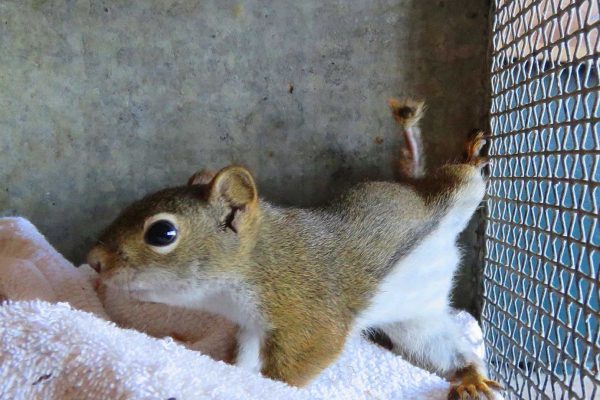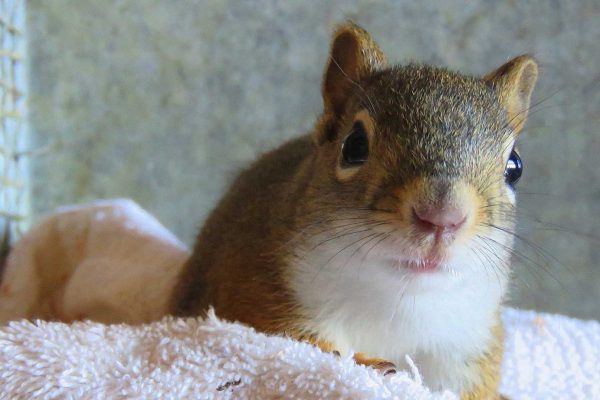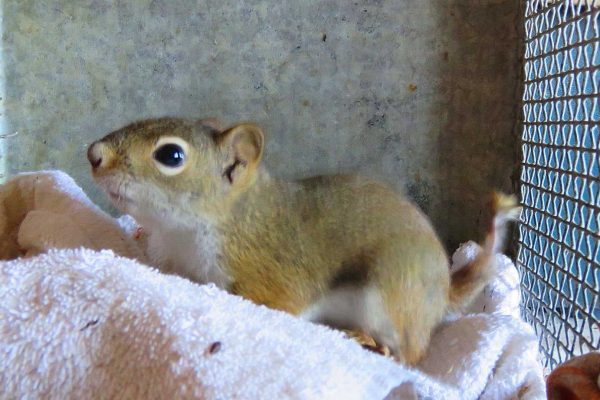Please note: This post contains descriptions of what happens to animals trapped in glue traps and may be upsetting to some readers.
I knew immediately what I wanted to write about this month after seeing a young red squirrel recently admitted to Duck Pond Wildlife Rehab – he was the sole survivor of his litter mates who had come in contact with a glue trap. Although typically used to control or eliminate insects, mice, and rats, these horrible traps are advertised as “a smart alternative to poisonous bait…non-toxic, easy to use and cost effective.” In reality, they are an ineffective, cruel, and dangerous way to rid your home of pests.

Red squirrel recovering at Duck Pond Wildlife Center. Photo by Jayne Winters
Also known as glue board traps or trays, they are simply flat pieces of cardboard or plastic covered with a specially designed sticky adhesive, either scented (such as peanut butter) or unscented. They are placed on floors flush against the wall where rodents often travel. Because it appears to be part of the floor, a mouse will walk across it and immediately become stuck, unable to free itself until it eventually dies: an often agonizingly slow death by starvation or suffocation. The Humane Society states “…they are responsible for more suffering than virtually any other wildlife control product on the market.” PETA, People for the Ethical Treatment of Animals, notes it is “one of the cruelest methods of killing animals in existence today.”
Although their popularity is in part due to claims of being safe to use, there are concerns. If an animal is still alive while glue-trapped, people often try to beat it to death. This is inhumane and carries the risk of being bitten or scratched by the terrified victim. Manufacturers suggest boards be thrown in the trash even if live animals are stuck to the surface, but they fail to mention the animals are left to struggle and die exhausted or injured days later. As observed with other trapped animals “they have been known to bite through their limbs in an attempt to free themselves.” These traps are also dangerous to household pets, no matter their size. Removal may require surgery by a veterinarian, but even if a cat or dog manages to pull the trap or tray off, it likely will lose fur and/or skin. In addition, the US Centers for Disease Control advise against using glue traps because they increase people’s exposure to a variety of pathogens transmitted by animal feces and urine.
Despite bans in several countries and territories, the US has placed no regulations on their use and has provided very little consumer education about their potential dangers. Hundreds of companies, however, prohibit their sale, including Target, Dollar General, Dollar Tree, Rite Aid, CVS, and Walgreens.

Photo by Jayne Winters
Other animals unintentionally trapped on these glue boards include chipmunks, opossums, birds, lizards, snakes, frogs, turtles – pretty much anything that lands on their surface. If you find an animal or bird caught on one of these traps, please consider it an emergency and contact either a vet or wildlife rehabber. Trying to release it yourself could cause further injury to the animal or possibly to you or anyone else attempting to help. Even if the animal doesn’t display injury, it is scared and in a stressful situation.
Killing wildlife is not a long-term solution for population control because survivors breed faster and more will move in to take the place of their deceased friends. Control of rodent populations should focus on removal of the cause and source, i.e., access and food. Plug entry holes with foam sealant, steel wool, hardware cloth, ammonia-scented rags/cotton balls or moth balls; store food items (especially pet food) in metal or airtight containers with lids, rather than in bags or boxes that can be chewed; remove clutter, grass clippings, and weeds that might be used for nest building; pick up fallen fruit and veggies; store grills, outdoor furniture, and wood piles away from buildings; and don’t feed wildlife, as grains and seeds will attract unwanted visitors. There are a variety of humane traps that catch critters alive for release away from your home, but free them in their natural territory so they can find shelter, food, and water. If lethal methods for rodent control are recommended, at least be sure they die quickly.
The red squirrel at Duck Pond was carefully removed from the glue trap, but unfortunately left fur behind and its tail gunked up with glue. Don had been advised by another rehabber to apply PAM Cooking Spray to the fur, followed after 15-20 minutes by gentle cleaning with Dawn detergent (yes, just like in the duckling commercial!). Three weeks later, Little Red is thriving and the fur is slowly growing back on his stumpy tail. Don asked that I mention if anyone has questions about removing glue or any adhesive from an animal, to please give him a call.

Photo by Jayne Winters
Regarding the chipmunk and grey squirrel that were hit by vehicles in October, we had a totally different outcome than expected. The chipmunk, which was barely moving and just beginning to eat on its own, has survived and is very active, with a good appetite and normal grooming habits. The squirrel, although by outward appearances seemingly to have suffered only minor injuries, did not survive. He apparently succumbed to severe internal organ damage or failure.
Don and his volunteers greatly appreciate other rehabbers who continue to generously provide assistance to help keep critter care at Duck Pond manageable. Please check the following web sites to see if there is one near you: www.mainevetmed.org/wildlife-rehabilitation or www.maine.gov/ifw/fish-wildlife/wildlife/living-with-wildlife/orphaned-injured-wildlife/index.html
Donald Cote operates Duck Pond Wildlife Care Center on Rte. 3 in Vassalboro. It is a nonprofit, State-permitted rehab facility, which is supported by his own resources and outside donations. Mailing address: 1787 North Belfast Avenue, Vassalboro ME 04989 Phone: (207) 445-4326. Please note that the prior wildlifecarecenter email address is no longer monitored.
—by Jayne Winters, Natural Resources Council of Maine member from South China, Maine
Critter Chatter also appears monthly in the Town Line newspaper.










Leave a Reply